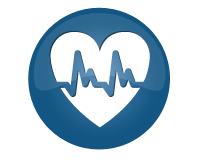
Areas of focus for VA research on cardiovascular disease include evaluating
and developing new treatments, probing the genetic and lifestyle causes of cardiovascular disease, and developing new rehabilitation methods, especially for stroke. Studies range from biomedical lab experiments on animal models of heart disease to large, multisite clinical trials
involving thousands of patients.
Examples of VA Research Advances
Heart attack on a chip—Researchers are testing a disposable microchip that can diagnose a heart attack in minutes. The chip senses molecules in saliva that are markers for a heart attack. Heart attacks currently are diagnosed with blood tests, which can take hours to complete, and echocardiograms, which miss the diagnosis in about a third of patients. Five hundred patients are being enrolled in the two-year study at the Houston VA. Popular Science gave the chip a "Best of What's New" technology award in 2008.
Better preventive therapy—Gastrointestinal complications such as ulcers and internal bleeding are serious side effects of the anti-clotting drugs taken to prevent heart attack and stroke. VA researchers and others found that patients taking anti-clotting drugs who also took a drug for ulcer relief were less likely to have these complications. The trial included 3,761 patients and lasted six months. All patients took aspirin and clopidogrel (sold as Plavix); half were given the anti-ulcer drug as well, while the other half took a placebo.
Modeling impact of salt reduction—Reducing American's sodium intake by about 10 percent would prevent
more than one million strokes and heart attacks and reduce the nation's medical costs by more than $32 billion, according to a model by VA researchers from Palo Alto. In partnership with Stanford University scientists, they also modeled the effects of a tax that would raise the prices of salty foods. That scenario was expected to cut sodium intake by about six percent. The recommended daily sodium intake for an adult is 2,300 mg; the average U.S. adult consumes 3,900 mg, most of which comes from processed foods.
Comparing bypass methods—In a clinical trial involving 757 patients at 11 VA medical centers, coronary artery bypass surgery had similar outcomes whether doctors used the radial artery (from the forearm, wrist and hand) or the saphenous vein (from the leg) to reroute blood flow to the heart. Contrary to what many surgeons have come to believe, using the arm artery didn't result in improved patency (the graft remaining open).
|